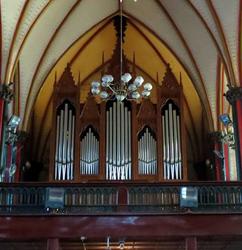
Casavant Frères, Limitée, of Saint-Hyacinthe, Québec, Canada, completed its first organ for a church in mainland China in late 2014. The North Cathedral “Beitang” in Beijing dedicated its new three-manual, 42-rank organ, Opus 3905, on December 7, before a capacity crowd. A recital was presented by Daniel Tappe of Germany. Chinese and Canadian media covered the event. The organ’s design is inspired by the 1888 Cavaillé-Coll organ originally installed in the cathedral.
Here in the United States, the firm finished its new two-manual organ for the United Methodist Church of Mount Vernon, Iowa, Opus 3901, dedicated September 14 in a recital by the church’s organist, Dr. Lynda Hakken.
In 2015, Casavant will be shipping an organ to St. Paul Parish in Bergen, Norway. The four-manual, 46-rank organ built in 1920 was salvaged from a closed church in Québec and thoroughly restored in Casavant’s shop. Installation will be completed in collaboration with Åkerman & Lund, an organbuilding firm established in Sweden in 1860.
For more information: www.casavant.ca.

